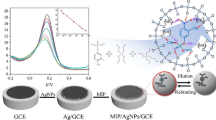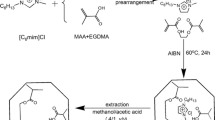Abstract
Sensors incorporating molecularly imprinted polymers (MIPs) are feasible in concept though the reproducibility of such devices can be compromised by the large number of interdependent steps. For this reason, many researchers have focused on the synthesis of MIP particles only, not on their immobilization. Herein is presented a sol–gel based method for immobilization of unmodified MIP particles for use in an electrochemical sensor. The macroporous particles were prepared using precipitation-polymerization and imprinted with theophylline. The sol–gel was combined with graphite microparticles (50 μm) and the composite was deposited on the surfaced of an epoxy-graphite electrode. The sensor was then tested for its response to theophylline using differential pulse voltammetry. A limit of detection of 1 μM was observed and a relative standard deviation of 6.85 %. The electrode can be regenerated via a thermal washing process which was accompanied by an initial signal loss of 29.3 %. Any further regeneration caused a signal loss of 2.4 % only.

A voltammetric sensor for the preferential detection of theophylline is prepared based on molecularly imprinted microspheres immobilized in a sol-gel layer. The use of precipitated polymer microparticles allows for the effective regeneration of the sensor using an acidic wash.








Similar content being viewed by others
References
Mello LD, Kubota LT (2002) Review of the use of biosensors as analytical tools in the food and drink industries. Food Chem 77(2):237–256
Kroger S, Turner APF, Mosbach K, Haupt K (1999) Imprinted polymer based sensor system for herbicides using differential-pulse voltammetry on screen printed electrodes. Anal Chem 71(17):3698–3702
Wulff G (2013) Fourty years of molecular imprinting in synthetic polymers: origin, features and perspectives. Microchim Acta 180(15–16):1359–1370
Whitcombe MJ, Kirsch N, Nicholls IA (2014) Molecular imprinting science and technology: a survey of the literature for the years 2004–2011. J Mol Recog 27(6):297–401
Yan HY, Row KH (2006) Characteristic and synthetic approach of molecularly imprinted polymer. Int J Mol Sci 7(5–6):155–178
Wulff G, Knorr K (2001) Stoichiometric noncovalent interaction in molecular imprinting. Bioseparation 10(6):257–276
Yoshimi Y, Ohdaira R, Iiyama C, Sakai K (2001) “Gate effect” of thin layer of molecularly-imprinted poly (methacrylic acid-co-ethyleneglycol dimethacrylate). Sensors Actuators B Chem 73(1):49–53
Sellergren B (1997) Noncovalent molecular imprinting: antibody-like molecular recognition in polymeric network materials. Trac-Trend Anal Chem 16(6):310–320
Cormack PAG, Elorza AZ (2004) Molecularly imprinted polymers: synthesis and characterisation. J Chromatogr B 804(1):173–182
Suryanarayanan V, Wu CT, Ho KC (2010) Molecularly imprinted electrochemical sensors. Electroanalysis 22(16):1795–1811
Sellergren B, Shea KJ (1995) Origin of peak asymmetry and the effect of temperature on solute retention in enantiomer separations on imprinted chiral stationary phases. J Chromatogr A 690(1):29–39
Barnes PJ (2010) Theophylline. Pharma 3(3):725–747
Alizadeh T, Ganjali MR, Zare M, Norouzi P (2010) Development of a voltammetric sensor based on a molecularly imprinted polymer (MIP) for caffeine measurement. Electrochim Acta 55(5):1568–1574
Ebarvia BS, Binag CA, Sevilla F 3rd (2004) Biomimetic piezoelectric quartz sensor for caffeine based on a molecularly imprinted polymer. Anal Bioanal Chem 378(5):1331–1337
Aranda M, Morlock G (2007) Simultaneous determination of caffeine, ergotamine, and metamizol in solid pharmaceutical formulation by HPTLC-UV-FLD with mass confirmation by online HPTLC-ESI-MS. J Chromatogr Sci 45(5):251–255
Tzanavaras PD, Themelis DG (2007) Development and validation of a high-throughput high-performance liquid chromatographic assay for the determination of caffeine in food samples using a monolithic column. Anal Chim Acta 581(1):89–94
Svorc L (2013) Determination of caffeine: a comprehensive review on electrochemical methods. Int J Electrochem Sci 8(4):5755–5773
Spataru N, Sarada BV, Tryk DA, Fujishima A (2002) Anodic voltammetry of xanthine, theophylline, theobromine and caffeine at conductive diamond electrodes and its analytical application. Electroanalysis 14(11):721–728
Perez-Moral N, Mayes AG (2004) Comparative study of imprinted polymer particles prepared by different polymerisation methods. Anal Chim Acta 504(1):15–21
Kan X, Zhao Q, Zhang Z, Wang Z, Zhu JJ (2008) Molecularly imprinted polymers microsphere prepared by precipitation polymerization for hydroquinone recognition. Talanta 75(1):22–26
Adhikari B, Majumdar S (2004) Polymers in sensor applications. Prog Polym Sci 29(7):699–766
Kriz D, Mosbach K (1995) Competitive amperometric morphine sensor-based on an agarose immobilized molecularly imprinted polymer. Anal Chim Acta 300(1–3):71–75
Patel AK, Sharma PS, Prasad BB (2009) Electrochemical sensor for uric acid based on a molecularly imprinted polymer brush grafted to tetraethoxysilane derived sol–gel thin film graphite electrode. Mater Sci Eng C 29(5):1545–1553
Prasad BB, Madhuri R, Tiwari MP, Sharma PS (2010) Electrochemical sensor for folic acid based on a hyperbranched molecularly imprinted polymer-immobilized sol–gel-modified pencil graphite electrode. Sensors Actuators B Chem 146(1):321–330
Takagishi T, Klotz IM (1972) Macromolecule-small molecule interactions - introduction of additional binding-sites in polyethyleneimine by disulfide crosslinkages. Biopolymers 11 (2):483-&
Mujahid A, Lieberzeit PA, Dickert FL (2010) Chemical sensors based on molecularly imprinted sol–gel materials. Mater 3(4):2196–2217
Ye L, Weiss R, Mosbach K (2000) Synthesis and characterization of molecularly imprinted microspheres. Macromolecules 33(22):8239–8245
Ocaña C, Arcay E, del Valle M (2014) Label-free impedimetric aptasensor based on epoxy-graphite electrode for the recognition of cytochrome c. Sensors Actuators B Chem 191:860–865
Patel AK, Sharma PS, Prasad BB (2008) Development of a creatinine sensor based on a molecularly imprinted polymer-modified sol–gel film on graphite electrode. Electroanalysis 20(19):2102–2112
Sherrington DC (1998) Preparation, structure and morphology of polymer supports. Chem Commun 21:2275–2286
Castell OK, Allender CJ, Barrow DA (2006) Novel biphasic separations utilising highly selective molecularly imprinted polymers as biorecognition solvent extraction agents. Biosens Bioelectron 22(4):526–533
Mohamed MH, Wilson LD (2012) Porous copolymer resins: tuning pore structure and surface area with non reactive porogens. Nanomater 2(2):163–186
Patel AK, Sharma PS, Prasad BB (2009) Electrochemical sensor for uric acid based on a molecularly imprinted polymer brush grafted to tetraethoxysilane derived sol–gel thin film graphite electrode. Mat Sci Eng C-Bio S 29(5):1545–1553
Patel AK, Sharma PS, Prasad BB (2009) Voltammetric sensor for barbituric acid based on a sol-gel derivated molecularly imprinted polymer brush grafted to graphite electrode Int J Pharm 371(1–2):47–55
Liu J, Chaudhury MK, Berry DH, Seebergh JE, Osborne JH, Blohowiak KY (2006) Effect of surface morphology on crack growth at a sol–gel reinforced epoxy/aluminum interface. J Adhes 82(5):487–516
Viana MM, Mohallem TDS, Nascimento GLT, Mohallem NDS (2006) Nanocrystalline titanium oxide thin films prepared by sol–gel process. Braz J Phys 36(3B):1081–1083
Brittain HG (2007) Profiles of drug substances, excipients and related methodology: critical compilation of pKa values for pharmaceutical substances, vol 33. Academic, San Diego CA
Castell OK, Barrow DA, Kamarudin AR, Allender CJ (2011) Current practices for describing the performance of molecularly imprinted polymers can be misleading and may be hampering the development of the field. J Mol Recog 24(6):1115–1122
Kirsch N, Hart JP, Bird DJ, Luxton RW, McCalley DV (2001) Towards the development of molecularly imprinted polymer based screen-printed sensors for metabolites of PAHs. Analyst 126(11):1936–1941
Lai EPC, Fafara A, VanderNoot VA, Kono M, Polsky B (1998) Surface plasmon resonance sensors using molecularly imprinted polymers for sorbent assay of theophylline, caffeine, and xanthine. Can J Chem 76(3):265–273
Wang Z, Kang J, Liu X, Ma Y (2007) Capacitive detection of theophylline based on electropolymerized molecularly imprinted polymer. Int J Polym Anal Charact 12(2):131–142
Niu J, Liu Z, Fu L, Shi F, Ma H, Ozaki Y, Zhang X (2008) Surface-imprinted nanostructured layer-by-layer film for molecular recognition of theophylline derivatives. Langmuir 24(20):11988–11994
Kan X, Liu T, Zhou H, Li C, Fang B (2010) Molecular imprinting polymer electrosensor based on gold nanoparticles for theophylline recognition and determination. Microchim Acta 171(3–4):423–429
Kim J-M, Lee U-H, Chang S-M, Park JY (2014) Gravimetric detection of theophylline on pore-structured molecularly imprinted conducting polymer. Sensors Actuators B Chem 200:25–30
Tan X, Wang L, Li P, Gong Q, Liu L, Zhao D, Lei F, Huang Z (2012) Electrochemical sensor for the determination of theophylline based on molecularly imprinted polymer with ethylene glycol maleic rosinate acrylate as cross-linker. Acta Chim Sin 70(9):1088–1094
Acknowledgments
This research was supported by the Research Executive Agency (REA) of the European Union under Grant Agreement number PITN-GA-2010-264772 (ITN CHEBANA), by the Ministry of Science and Innovation (MCINN, Madrid, Spain) through the project CTQ2010-17099 and by the Catalonia program ICREA Academia.
Author information
Authors and Affiliations
Corresponding author
Rights and permissions
About this article
Cite this article
Bates, F., del Valle, M. Voltammetric sensor for theophylline using sol–gel immobilized molecularly imprinted polymer particles. Microchim Acta 182, 933–942 (2015). https://doi.org/10.1007/s00604-014-1413-4
Received:
Accepted:
Published:
Issue Date:
DOI: https://doi.org/10.1007/s00604-014-1413-4




